My Back Yard
By Jimmy R. Hammond
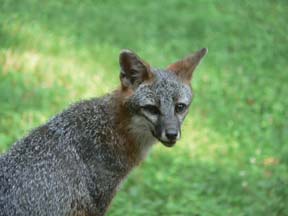
Our community of Annapolis Roads was started in the 1920s with guarded gate access, a grand club house, an Olympic size pool, tennis courts, a 100-foot pier into the Bay and a golf course. By the time we arrived in the 1970s, the community had retreated from its early grandeur and now had approximately 200 homes, a golf course, a pool that would close shortly thereafter and 30 or 40 acres of undisturbed woods. Thirty years later the number of homes has grown to more than 300, the children have children of their own, the golf is course is still a golf course and the undisturbed acreage remains intact. We have tried several times over 31 years to move, but each time we tried we would return to our home nestled gently next to those inviting and always beautiful woods.
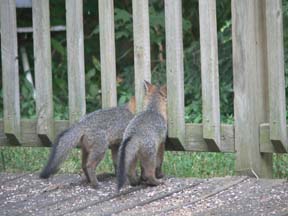 Our proximity to the woods has given us countless hours of pleasure. As amateur birders, we are always thrilled to discover a new feathered creature just outside our windows. Never mind the occasional angel wing patterns that mysteriously appear on our windows from time to time, when a little feathered friend tries to take a short-cut through our kitchen. Most survive the sudden stop after a brief respite on the deck! Our proximity to the woods has given us countless hours of pleasure. As amateur birders, we are always thrilled to discover a new feathered creature just outside our windows. Never mind the occasional angel wing patterns that mysteriously appear on our windows from time to time, when a little feathered friend tries to take a short-cut through our kitchen. Most survive the sudden stop after a brief respite on the deck!
It has been a couple years now since my wife’s mother lived with us, but during the year she was with us the bird population seemed to increase exponentially. Different varieties greeted us each morning and evening as they waited for their daily feedings. Blackbirds, cat birds, cow birds, cardinals, crows, blue birds, purple finches, juncos, snow birds, chickadees, orioles, purple grackles, blue jays, flickers, doves, pileated woodpeckers, robins, thrushes, titmice, nuthatches, wrens, sparrows, hummingbird, indigo bunting, warblers, herons, osprey, hawks—and an occasional turkey vulture for good measure. It is worth noting that our squirrel population did nothing to deter our feathered friends. It became a daily ritual that year as we watched our feathered population expand. Looking back at that period, I think the increase was probably due to a combination of food, our cats becoming indoor pets and—I still believe—the audience we provided.
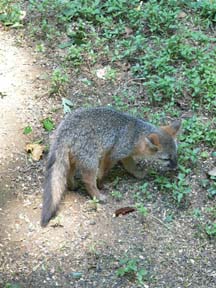 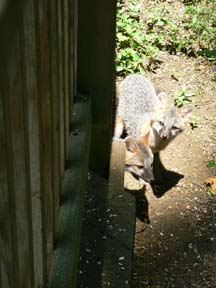
Then came the spring of 2005, when I was summoned to the window by my wife for the surprise of a lifetime. There before our eyes, within 15 feet of our kitchen window, was a male gray fox and his three bouncing baby kits. I can’t describe our surprise, our thrill and then concern. With all the zeal of an excited scientist making some profound discovery, we ran to the internet to find all we could about the new visitors who had taken up residence under our pool deck.
We discovered that the grey fox stands about 12-16 inches at the shoulders, weighs up to 16 pounds and has an overall body length of up to 47 inches, including the tail. The grey fox has the unique ability to climb trees and has perfected the “mouse pounce,” a common food-catching technique. They are monogamous animals—they mate once a year between December and April and, after a 62 day gestation period, yield two to eight kits. The adults share parenting duties throughout the maturing cycle of the kits.
Their eating habits were interesting and the variety of food items was extensive. Most literature referred to them as opportunistic foragers and said that their primary diet consists of berries, grains, mice, fish, reptiles, eggs and an occasional bird.
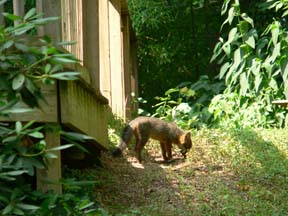 Our extended reading about gray foxes led us to conclude that our new kits were about 4-6 weeks old, which meant that they were beginning to roam and play and that their diet was changing from mother’s milk to solid foods. According to the reference material, they would be foraging on their own within a couple months. It was a pure delight to watch the little guys grow, play and learn to climb our pine trees. They were also great dinner guests when they would eat side-by-side with raccoons and opossums, with nary a fuss. We felt like grandparents watching their first grandchild learn to walk and talk. We sensed their comfort with our presence immediately, and soon we added dry pet food to the daily feeding ritual. Like clockwork, one or more of the kits, in a defined pecking order, would appear in the morning often waiting for me at the door for breakfast. It was like having 3 little puppies jumping and playing waiting to be fed! It was always very amusing when we would caution yard helpers not to be alarmed when the kits came out to play. Our extended reading about gray foxes led us to conclude that our new kits were about 4-6 weeks old, which meant that they were beginning to roam and play and that their diet was changing from mother’s milk to solid foods. According to the reference material, they would be foraging on their own within a couple months. It was a pure delight to watch the little guys grow, play and learn to climb our pine trees. They were also great dinner guests when they would eat side-by-side with raccoons and opossums, with nary a fuss. We felt like grandparents watching their first grandchild learn to walk and talk. We sensed their comfort with our presence immediately, and soon we added dry pet food to the daily feeding ritual. Like clockwork, one or more of the kits, in a defined pecking order, would appear in the morning often waiting for me at the door for breakfast. It was like having 3 little puppies jumping and playing waiting to be fed! It was always very amusing when we would caution yard helpers not to be alarmed when the kits came out to play.
As many others who experienced this joy said, “the departure would be sudden and too soon.” We sadly concur.
We occasionally have one or more of the family revisit from time to time, usually at night, so that it is hard to distinguish who is who, but we know they are our kits all grown up. I may have a new story to tell soon—a red fox showed up this year with two kits. Here we go again.
Back |

